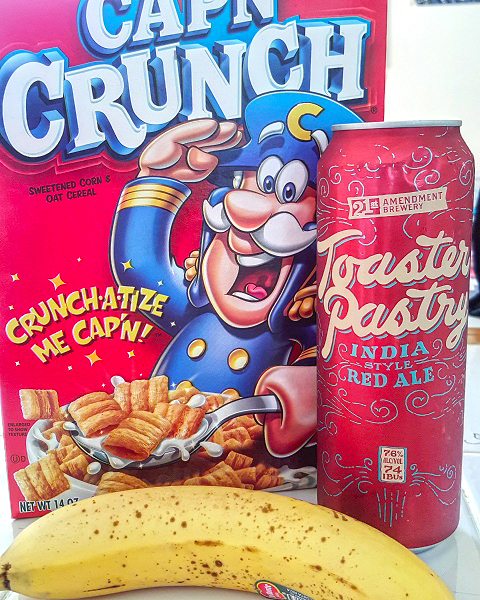Start 14-Day Trial Subscription
*No credit card required

Table Beer and Red IPA
Table Beer
The American beer scene has been inundated with double digit ABV bombs – if not a molasses-like Imperial Stout, then a Double IPA with enough hops to sedate a large farm animal. As a result, we have seen an increased focus on session beers, meant to be consumed in reasonable quantities without fear of keeling over at the bar.
Belgian Table Beer, or tafelbier in its native tongue, could be considered the original session beer, intended for refreshment, a source of clean water and nutrition due to unfiltered Vitamin-B rich yeast contained within the bottle. Benefits of B-Vitamins include enhanced energy metabolism, and support of the nervous system, digestive system, skin, hair, eyes, mouth and liver. Its pro-digestive qualities and lightness in body made it a perfect lunchtime beverage for adults and children alike – traditionally, even Belgian schoolchildren were allowed to partake.
The style is characterized by a low alcohol content ranging from .5% to 3.5% ABV, minimal bitterness, and Belgian yeast character, often coupled with wild yeasts like lactobacillus or Brettanomyces, which can lend mild sourness and barnyard funk according to the Brewers Association’s 2015 Beer Style Guidelines (the style is not explicitly recognized by the BJCP.)
Belgian Table Beers are thin in body, but can gain considerable character from classic Belgian yeast byproducts of esters, which can include fruity notes of banana, bubblegum or pear, and phenols, which can contribute clove-like flavors and aromas along with the classic horseblanket aroma associated with Bretts.
In keeping with the easily digestible theme, Belgian Table Beers pair well with almost all foods. They are typically low in carbonation and aftertaste, as they are generally very lightly hopped, if at all, and display only a mild malty character.
Their aroma is similarly subdued, although in more modern versions spices such as lemon peel, orange peel or coriander are occasionally added for mild aroma and flavor. The color of Belgian Table Beer can vary from gold to black, although it will generally skew towards the lighter end of the spectrum due to a typically subdued mashing process.
American brewers have caught on to the style, concocting their own interpretations, which strike a balance between the traditional style and slightly bolder flavors, occasional post-fermentation ingredient additions and a somewhat higher ABV in tune with American drinking sensibilities. No matter the interpretation, the spirit of Belgian Table Beers emphasizes conviviality – a tool to enhance our shared experience around a table, rather than blot it out entirely.
STATS: OG: 1.008 – 1.038
IBUs: 5 – 15
SRM: 5 – 50
ABV: 0.5 – 3.5%,
Commercial Examples: Jester King Le Petit Prince, Brasserie Dupont Avril, Dangerous Man Belgian Table Beer, New Albanian Tafelbier, Smuttynose Hayseed, Notch Brewing Tafelbier, White Sails Buttertubs Tafelbier, Green Bench Les Grisettes
Red IPA
I know what you’re thinking: “Another IPA style? Boring!” But bear with me. While American IPAs are ubiquitous and bordering on omnipresent, the specialty styles are not quite so common.
Last issue’s IPA research was done on the fairly rare Black IPA style, and this issue, we’ve decided to discover the backstory for Red IPAs, a recently-adopted BJCP style (much like all the specialty IPA entries).
 Red IPAs are a cross between American Amber Ales and American IPAs, and the style’s nomenclature is further confused by ambers being called “red ales” sometimes. Red IPAs were certainly an offshoot of the American Amber style, with early adopters such as Green Flash’s Hop Head Red and Sierra Nevada’s Flipside Red confounding tastemakers and name raters by combining the hugely hoppy presence of an IPA with the deep ruby color and hefty malt backbone of an American Amber.
Red IPAs are a cross between American Amber Ales and American IPAs, and the style’s nomenclature is further confused by ambers being called “red ales” sometimes. Red IPAs were certainly an offshoot of the American Amber style, with early adopters such as Green Flash’s Hop Head Red and Sierra Nevada’s Flipside Red confounding tastemakers and name raters by combining the hugely hoppy presence of an IPA with the deep ruby color and hefty malt backbone of an American Amber.
While American Ambers keep malt in the forefront, the hops are the star of the show in Red IPAs. They typically feature both a New World (Mosaic, Citra, Galaxy) and classic American (Centennial, Cascade) varietal. Well-made examples also retain the quaffability of the IPA style without veering into an overly sweet, cloying malt bomb.
In the aroma, characteristically fruity, piney and resinous hops should give way to a toasty, caramelly and toffee-like character. Flavor should follow suit – hops should come on strong upon first sip, reflecting the American or New World varietals. Medium-to-high bitterness should be clean and snappy, inviting the drinker to take another swig.
Despite the malt levels being high, they should only complement the hops and never constrain the bitterness and hop flavors (remember, this is an IPA after all).
Another major concern of the Red IPA is the mouthfeel – one of this style’s defining characteristics. While many higher-ABV American IPAs can be astringent and harsh due to high bitterness and hopping rates, the de-bittered dark crystal malts that Red IPAs employ should make for a smooth, easy-drinking brew in well-made examples of the style.
Overall, Red IPAs should convey an even balance between malt and hops, while still retaining the high levels of each found in American IPAs and Amber Ales. With more commercial examples becoming available every day, this easy-drinking and dense IPA style is here to stay, and it gives new meaning to the phrase “seeing red.”
STATS:
OG: 1.056 – 1.070
IBUs: 40 – 70
SRM: 11 – 19
ABV: 5.5 – 7.5%
Commercial Examples: 21st Amendment Toaster Pastry, Odell Runoff Red, Motorworks Rollcage Red, Sierra Nevada Flipside Red IPA, Lakefront Fixed Gear, Starr Hill Reviver Red IPA



